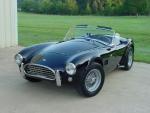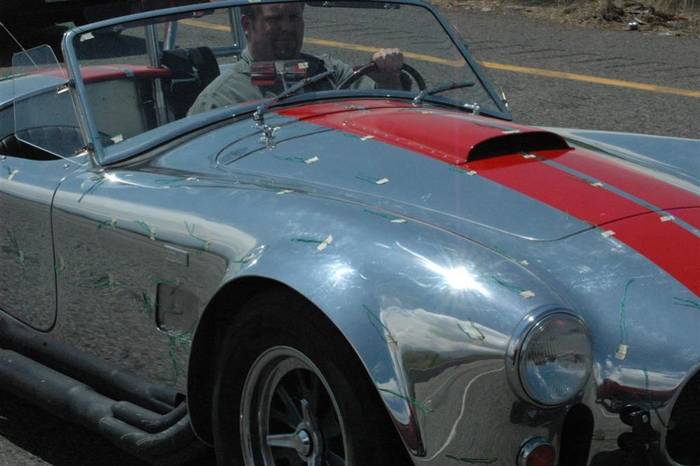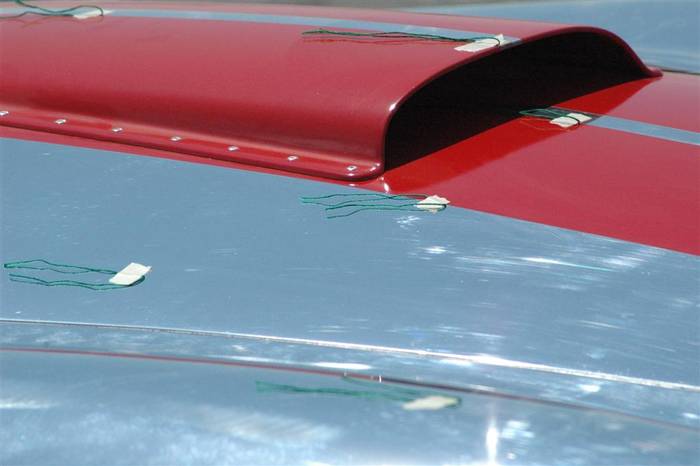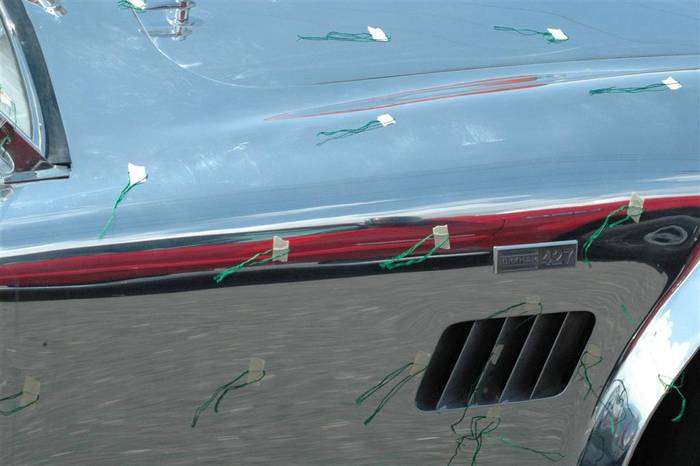 
 Main Menu
Main Menu
|
 Nevada Classics
Nevada Classics
|
 Advertise at CC
Advertise at CC
|
| S |
M |
T |
W |
T |
F |
S |
| |
|
|
|
|
1 |
2 |
| 3 |
4 |
5 |
6 |
7 |
8 |
9 |
| 10 |
11 |
12 |
13 |
14 |
15 |
16 |
| 17 |
18 |
19 |
20 |
21 |
22 |
23 |
| 24 |
25 |
26 |
27 |
28 |
29 |
30 |
|
 CC Advertisers
CC Advertisers
|
|
 39Likes 39Likes

05-03-2019, 09:42 AM
|
|
CC Member

|
|
|
Join Date: Jan 2018
Cobra Make, Engine:
Posts: 114
|
|

 Not Ranked
Not Ranked
I still would like to see some string laid out onto the hood in front of the scoop. This will dictate the air flow going into the scoop. Instead of hanging them on top of the scoop. Placement should be a third and 2/3 in front of the scoop we could see what the strings are doing as the air goes into the scoop. The problem I have an issue with the scoop is that it is too low in height.
|

05-03-2019, 10:09 AM
|
|
Club Cobra Member

|
|
|
Join Date: Mar 2002
Location: arroyo grande, ca,
ca
Cobra Make, Engine: NAF 427
Posts: 1,774
|
|

 Not Ranked
Not Ranked
Patience grasshopper. The knowledge will come.
Cheers
Greg
|

05-03-2019, 10:15 AM
|
|
Club Cobra Member

|
|
|
Join Date: Mar 2002
Location: arroyo grande, ca,
ca
Cobra Make, Engine: NAF 427
Posts: 1,774
|
|

 Not Ranked
Not Ranked
Hey cycleguy. Do you know the dimensions of the hood scoop opening (height and width) in the video?
Most scoop openings seem to range from 1.5 to 2 inches in height and 14 to 15 inches in width
Cheers
Greg
|

05-03-2019, 12:17 PM
|
|
CC Member

|
|
|
Join Date: Apr 1999
Location: cleveland,
OH
Cobra Make, Engine: CSX4000, 427
Posts: 1,999
|
|

 Not Ranked
Not Ranked
Hello Greg.
My scoop has the curved leading edge. It's taller, and wider than the standard scoop, but because it's wider, it sits on a lower portion of the hood, so the height of the scoop at the center of the hood is not that much different than that of the standard scoop.
Yes, those intakes are part of my collection of parts that at one time I fantasized about utilizing ! I believe there were only about 10-20 pairs of original weber 58mm downdrafts ever made, I think initially for Indy cars. Hilborn fabricated mechanical fuel injeciton throttle bodies to the 58mm weber intake.
__________________
"After jumping into an early lead, Miles pitted for no reason. He let the entire field go by before re-entering the race. The crowd was jumping up and down as he stunned the Chevrolet drivers by easily passing the entire field to finish second behind MacDonald's other team Cobra. The Corvette people were completely demoralized."
|

05-03-2019, 05:30 PM
|
|
Club Cobra Member

|
|
|
Join Date: Mar 2002
Location: arroyo grande, ca,
ca
Cobra Make, Engine: NAF 427
Posts: 1,774
|
|

 Not Ranked
Not Ranked

So I've learned from Ned Scudder at SAAC that the original 289 race car hood scoops were aluminum.
But there were only 6 initial factory race cars growing to 32 cars in total over the Cobra's 3 year race history.
So aluminum may have made sense initially as the numbers were small.
And that might explain the wide variety of hood scoop configurations shown in period photos as they might have been hand-made aluminum , being replaced as necessary due to damages.
But as more Cobra race cars were added and later in the race history perhaps they switched to fiberglass and finalized on one configuration.
A configuration that was eventually handed down to the 427 Cobra in 1965.
Now the first production line 427 Cobra, CSX 3003, to come off the AC production line in Nov ’65 carried a hood bubble rather than a hood scoop:

Sure looks like that hood bubble was a carry-over from The Turd:

But by the time CSX3003 was finally completed at the Shelby Venice facility in May ’65 it carried a hood scoop similar to the later 289 race car hood scoops and looked to be fiberglass:

So where did that bubble hood go?
Could that hood be hanging on a wall somewhere?
Or was the bubble cut out of CSX 3003s original hood and then a fiberglass hood scoop added?
“You are traveling through another dimension, a dimension not only of sight and sound but of mind. A journey into a wondrous land whose boundaries are that of imagination.
Your next stop, the Twilight Zone.”
Cheers
Greg
Last edited by my427cobra; 05-05-2019 at 08:07 AM..
|

05-03-2019, 07:02 PM
|
 |
CC Member

|
|
|
Join Date: Apr 2005
Location: Tucson,
AZ
Cobra Make, Engine:
Posts: 5,391
|
|

 Not Ranked
Not Ranked
Hey Greg, I believe the bottom photo is CSX3002. Could be wrong but I think it is.
Larry
__________________
Alba gu brŗth
|

05-04-2019, 06:29 AM
|
 |
CC Member

|
|
|
Join Date: Apr 2004
Posts: 1,029
|
|

 Not Ranked
Not Ranked
Quote:
Originally Posted by LMH

Hey Greg, I believe the bottom photo is CSX3002. Could be wrong but I think it is.
Larry
|
It is CSX3002.
__________________
Dan Case
1964 Cobra owner since 1983, Cobra crazy since I saw my first one in the mid 1960s in Huntsville, AL.
|

05-04-2019, 07:29 AM
|
|
Club Cobra Member

|
|
|
Join Date: Mar 2002
Location: arroyo grande, ca,
ca
Cobra Make, Engine: NAF 427
Posts: 1,774
|
|

 Not Ranked
Not Ranked
Hi guys. You are right. It is CSX3002.
Fat fingered typing. I don't think I've seen an early pic of CSX3003.
Another pic of CSX3002:
Cheers
Greg
|

05-04-2019, 02:35 PM
|
 |
Senior Club Cobra Member

|
|
|
Join Date: Mar 2005
Location: Manchester,
NH
Cobra Make, Engine: AK1085 (302 Street), HTM111 (427 Comp), CSX2375R (289 Comp) and COB5999 (427 S/C)
Posts: 18,997
|
|

 Not Ranked
Not Ranked
Love this curvaceous talk
Last edited by 1985 CCX; 05-18-2019 at 02:24 AM..
|

05-05-2019, 08:09 AM
|
|
Club Cobra Member

|
|
|
Join Date: Mar 2002
Location: arroyo grande, ca,
ca
Cobra Make, Engine: NAF 427
Posts: 1,774
|
|

 Not Ranked
Not Ranked
Need to apologise to Ned Scudder at SAAC for spelling his name wrong in a previous post. (now corrected)
Sorry Ned.
Cheers
Greg
|

05-06-2019, 08:50 AM
|
|
Club Cobra Member

|
|
|
Join Date: Mar 2002
Location: arroyo grande, ca,
ca
Cobra Make, Engine: NAF 427
Posts: 1,774
|
|

 Not Ranked
Not Ranked
Here's a pic of the Flip Top that I grabbed from Jac Mac's posting on the Shelby related pics thread.
CSX 2196 after a mid '90s restoration:

Good shot of the hood scoop.
Cheers
Greg |

05-07-2019, 01:29 PM
|
|
Club Cobra Member

|
|
|
Join Date: Mar 2002
Location: arroyo grande, ca,
ca
Cobra Make, Engine: NAF 427
Posts: 1,774
|
|

 Not Ranked
Not Ranked
Just to add to the pics of different Cobra hood scoops, here is a pic of CSX 3208 after a restoration in 1991.
Cammer engine and tall air horns on the Lucas/Kinser fuel injection on a Hilborn manifold.
Cheers
Greg
|

05-07-2019, 04:15 PM
|
|
CC Member

|
|
|
Join Date: Dec 2003
Location: Gurnee,
IL
Cobra Make, Engine: Kirkham #259
Posts: 1,396
|
|

 Not Ranked
Not Ranked

Quote:
Originally Posted by Jdata

I still would like to see some string laid out onto the hood in front of the scoop. This will dictate the air flow going into the scoop. Instead of hanging them on top of the scoop. Placement should be a third and 2/3 in front of the scoop we could see what the strings are doing as the air goes into the scoop. The problem I have an issue with the scoop is that it is too low in height.
|
Here's a couple of photo's Tom Kirkham took for me when we were discussing the Aero package we were putting on KMP259...
I thought you like to see...

Look closely at the scoop and the side Vents.

Now you can see what the yarn was doing at the Scoop....

Now you can see why I said many times there is no air coming out of the side vents.... the Boundary Layer is moved by the width of the front tires and fender and that causes turbulence where the Vent should be letting air out of the engine compartment. When the Boundary layer separates from the body.... all kind of Turbulence happens around the car.
Sorry for the long post.
__________________
Morris
|

05-07-2019, 04:36 PM
|
|
Club Cobra Member

|
|
|
Join Date: Mar 2002
Location: arroyo grande, ca,
ca
Cobra Make, Engine: NAF 427
Posts: 1,774
|
|

 Not Ranked
Not Ranked
So Morris, it seems your middle close-up pic of the front of the hood scoop shows the yarn flowing INTO the hood scoop opening.
Too bad there hadn't been a few more tufts in front of the hood scoop opening.
And I would suggest about the side vents:
1) yarn placement as shown in the pic doesn't necessarily say no air is coming from the vents
2) the movement of the boundary layer along the side of the car at speed would be sufficient to draw (venturi effect) air out of the vent and given the air is hot and less dense would simply blend easily with the boundary layer and would not look like some kind of jet blast coming out of the vents.
3) a better test of the air coming out of the vents would be a smoke generator inside the fender or at least yarn place inside the vents to confirm the air flow.
4) keep in mind the bulk of the air exiting the engine compartment is down and under the car.
Just thinking.
Cheers
Greg
|

05-07-2019, 05:00 PM
|
|
Club Cobra Member

|
|
|
Join Date: Mar 2002
Location: arroyo grande, ca,
ca
Cobra Make, Engine: NAF 427
Posts: 1,774
|
|

 Not Ranked
Not Ranked
I should have also said the angle of the vanes in the vent also contributes to the venturi effect and how easily the air blends into the boundary layer.
Without the vanes, just a big hole would not be effective in sucking air out.
But great pics Morris.
All help in getting to the answer.
I'm going to do a similar test when I get my scoop mounted.
I'm also planning a static tuft test using 3 large box fans in front of the car while at rest.
Then of course a moving tuft test,
Cheers
Greg
|

05-07-2019, 05:14 PM
|
|
CC Member

|
|
|
Join Date: Jan 2018
Cobra Make, Engine:
Posts: 114
|
|

 Not Ranked
Not Ranked
Thank you Morris
|

05-08-2019, 06:55 PM
|
|
CC Member

|
|
|
Join Date: Dec 2003
Location: Gurnee,
IL
Cobra Make, Engine: Kirkham #259
Posts: 1,396
|
|

 Not Ranked
Not Ranked
Quote:
Originally Posted by my427cobra

2) the movement of the boundary layer along the side of the car at speed would be sufficient to draw (venturi effect) air out of the vent and given the air is hot and less dense would simply blend easily with the boundary layer and would not look like some kind of jet blast coming out of the vents.
|
There is no boundary layer along the side of the car, because of the width of the front tires and fender.....thatís why the yarn is turbulent where the vent is....
The vent on the side of the body is to inboard of the front wheels & fender causing the boundary layer to not be attached to the body at that point....which was why I put the vents up on the hood so the boundary layer could draw the air out of the engine compartment.....thru the vents on the hood.
__________________
Morris
|

05-08-2019, 09:21 PM
|
 |
CC Member

|
|
|
Join Date: Jan 2018
Location: Lafayette,
IN
Cobra Make, Engine: Looking to buy
Posts: 1,295
|
|

 Not Ranked
Not Ranked
It looks like they have the ducted radiator exits in the top of the hood to get downforce. I'd like to do that with my VSE.
__________________
 Cobra loving, autocrossing Grandpa Architect.
|

05-09-2019, 11:47 AM
|
|
Club Cobra Member

|
|
|
Join Date: Mar 2002
Location: arroyo grande, ca,
ca
Cobra Make, Engine: NAF 427
Posts: 1,774
|
|

 Not Ranked
Not Ranked
Hi Morris. You are right. Well, we're both right.
The air flow is disturbed by the wheel arch and the spinning wheel/tire, and separates from the body.
That puts the boundary layer into a series of vortexes over the vent area. Without actual smoke testing we might only be guessing what is happening to the air movement in the vent.
I'll tuft test it his weekend if it doesn't rain.
A vent in the hood a an excellent alternative.
Cheers
Greg
|

05-09-2019, 04:29 PM
|
|
Club Cobra Member

|
|
|
Join Date: Mar 2002
Location: arroyo grande, ca,
ca
Cobra Make, Engine: NAF 427
Posts: 1,774
|
|

 Not Ranked
Not Ranked

Tuft testing: let the fun begin!
So letís use a casual engineering approach to this test in a form others easily can duplicate if they so choose so we can get comparative data.
Step 1: The static test
Iím going to start my car (motor idling so it heats up a little and so I donít wear the battery down while running the fans) in the garage or in the driveway.
Again, a static test with the car at rest, not in motion.
Iím going to test two areas (I donít have a hood scoop yet Ė coming this summer).
A) Side vents
I will attach tufts inside the wheel well ( driver side and passenger side) onto the vent vanes to see how they move when:
1) Front pusher fans only are ON
2) Rear puller fan only is ON
B) Radiator shroud/rear puller fan cage
I will attach tufts to the radiator shroud, rear puller fan cage, and a few places on the front of the engine to see how they move when:
1) Front pusher fans only are ON
2) Rear puller fan only is ON
All of this will give me a preliminary indication of where the air is moving while the car is static.
I am using this approach, because, when Iím driving the car and come to a stop sign, and my puller fan is ON, I can reach my left hand outside the car and forward to the vent, and I feel a large amount of air coming out of the vent.
I want to confirm this with tufts.
Thatís my first step this weekend.
Next- Step 2: The moving test.
Stay tuned.
Cheers
Greg
|
 Posting Rules
Posting Rules
|
You may not post new threads
You may not post replies
You may not post attachments
You may not edit your posts
HTML code is Off
|
|
|
All times are GMT -7. The time now is 04:12 PM.
Links monetized by VigLink
|


